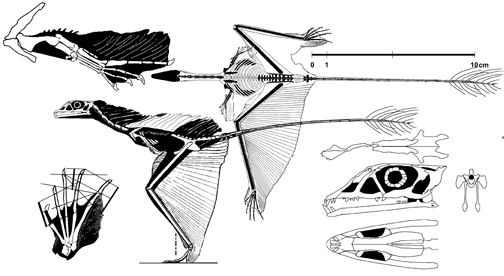Delta-winged aircraft have been around for several decades, and their use has revolutionized the aerospace industry. Yet apparently nature had already designed a delta-winged glider long before humans had lifted themselves off of the ground. Delta wing designs are named for their triangular shape, and roughly 225 million years ago nature had produced a small, bipedal, lizard-like glider with a similarly triangular shape.
Sharovipteryx was first discovered in 1965 by Alexander Sharov while he was collecting fossilized insects in Kyrgyzstan. Dating back to the Triassic period, it predated the adaptations of pterosaurs and other flyers by having the first known example of membranes attached to its hind limbs. The fossil of Sharovipteryx, shows that the hind legs possessed membranes that connected to the base of the tail, essentially giving it a pair of wings in the center of its body as opposed to its center of gravity.
Many researchers have questioned the effectiveness of an arrangement where the wings are between the hind legs and the base of the tail, and for obvious reasons. If the wings are not positioned close to the center of gravity, the glider/flyer in question is likely to tip one way or the other. In the case of Sharovipteryx, the greater mass in front would have caused a noticeable downward pitch, making the glide far less efficient.
Researchers from the University of Dublin and the University of Leeds have examined the gliding mechanism of Sharovipteryx in detail. They have come to believe that the fossil also shows a membrane in front of its hind legs, possibly even connecting to the front legs, which would resemble the membrane of a flying squirrel, in addition to the rear membranes.
Such a shape would create a delta wing design where the profile of the animal mid-glide would show a distinctive triangular shape. In order for the animal to have gained maximum efficiency with this design, a third membrane has been proposed to have stretched from the front arms to the base of the head, given credence by the fact that the head region is poorly preserved. This means that in order to control flight speed for landing, it would only have had to alter the shape, and thereby the area, of its wings by positioning its legs accordingly. Such a shape would also have greatly improved balance during flight, and the model created by the team yielded greater flight performance than today’s gliding lizards of the Draco genus.
Sources:
- Flight of Sharovipteryx mirabilis: the world’s first delta-winged glider
G. J. Dyke, R. L. Nudds, J. M. V. Rayner, J. Evolutionary Biology (2006) - Sharov’s Wondrous Wing, at The Hairy Museum of Natural History
- Sharovipteryx article in Wikipedia



2 Comments
Lorena Barba posted on November 18, 2011 at 9:14 pm
Hi Andrew – I embedded the figures that you had linked to.
It looks like the fossil evidence for this little guy is much too scant. They should put some models in the wind tunnel and study the various possibilities for this glider’s anatomy!
Andrew Chalifoux posted on November 20, 2011 at 4:16 pm
Actually they have. The researchers that studied this tried a variety of configurations and eventually came up with their own model (which is pictured here) for what would have been the most aerodynamic design based on wind tunnel tests. The first link is to their experiment and one of the images shows the configurations they tried.